| Article ID | Journal | Published Year | Pages | File Type |
|---|---|---|---|---|
| 2819233 | Gene | 2008 | 4 Pages |
A crucial pre-requisite for large-scale annotation of eukaryotic genomes is the definition of what constitutes a gene. This issue is addressed here in the light of novel and surprising gene features that have recently emerged from large-scale genomic and transcriptomic analyses. The updated operational definition proposed here is: “a gene is a discrete genomic region whose transcription is regulated by one or more promoters and distal regulatory elements and which contains the information for the synthesis of functional proteins or non-coding RNAs, related by the sharing of a portion of genetic information at the level of the ultimate products (proteins or RNAs)”. This definition is specifically designed for eukaryotic chromosomal genes and emphasizes the commonality of the genetic material that gives rise to final, functional products (ncRNAs or proteins) derived from a single gene. It may be useful in several applications and should help in the provision of a comprehensive inventory of the genes of a given organism, finally allowing answers to the basic question of “how many genes” are encoded in its genome.
